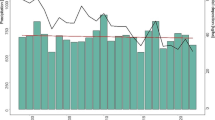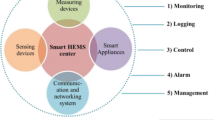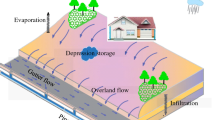Abstract
Water distribution systems (WDSs) today are expected to continuously provide clean water while meeting users demand, and pressure requirements. To accomplish these targets is not an easy task due to extreme weather events, operative accidents and intentional attacks; as well as the progressive deterioration of the WDS assets. Therefore, water utilities should be ready to deal with a range of disruption scenarios such as abrupt variations on the water demand e.g. caused by pipe bursts or topological changes in the water network. This paper presents a novel methodology to automatically split a WDS into self-adapting district metered areas (DMAs) of different size in response to such scenarios. Complex Networks Theory is proposed for creating novel multiscale network layouts for a WDS. This makes it possible to automatically define the dynamic partitioning of WDSs to support further DMA aggregation / disaggregation operations. A real, already partitioned, water utility network shows the usefulness of an adaptive partitioning when the network is affected by an abnormal increase of the peak demand of up to 15%. The dynamic DMA reuses the assets of the static partitioning and, in this case, up to the 82% of resilience is restored using 94% of the assets already installed. The results also show that the overall computational and economic management costs are reduced compared to the static DMA partition while the hydraulic performance of the WDS is simultaneously preserved.






Similar content being viewed by others
References
Alvisi S (2015) A new procedure for optimal design of district metered areas based on the multilevel balancing and refinement algorithm. Water Resour Manag 29 (12):4397–4409
Azevedo BB, Saurin TA (2018) Losses in water distribution systems: a complexity theory perspective. Water Resour Manag 32(9):2919–2936
Bair E (2013) Semi-supervised clustering methods. Wiley Interdisciplinary Reviews: Computational Statistics 5(5):349–361
Charalambous B (2008) Use of district metered areas coupled with pressure optimisation to reduce leakage. Water Sci Technol Water Supply 8(1):57–62
Ciaponi C, Murari E, Todeschini S (2016) Modularity-based procedure for partitioning water distribution systems into independent districts. Water Resour Manag 30(6):2021–2036
Ciaponi C, Creaco E, Di Nardo A, Di Natale M, Giudicianni C, Musmarra D, Santonastaso GF (2019) Reducing impacts of contamination in water distribution networks: a combined strategy based on network partitioning and installation of water quality sensors. Water 11(6):1315
Deuerlein JW (2008) Decomposition model of a general water supply network graph. J Hydraul Eng 134(6):822–832
Di Nardo A, Di Natale M, Gargano R, Giudicianni C, Greco R, Santonastaso GF (2018) Performance of partitioned water distribution networks under spatial-temporal variability of water demand. Environmental Modelling & Software 101:128–136
Farah E, Shahrour I (2017) Leakage detection using smart water system: combination of water balance and automated minimum night flow. Water Resour Manag 31(15):4821–4833
Feng J, Zhang H (2006) Algorithm of pipeline leak detection based on discrete incremental clustering method. In: International conference on intelligent computing. Springer, pp 602–607
Ferrari G, Savic D, Becciu G (2013) Graph-theoretic approach and sound engineering principles for design of district metered areas. J Water Resour Plan Manag 140(12):04014036
Fortunato S, Hric D (2016) Community detection in networks: a user guide. Phys Rep 659:1–44
Girvan M, Newman M (2002) Community structure in social and biological networks. Proc Natl Acad Sci USA 99:7821–7826
Giudicianni C, Di Nardo A, Di Natale M, Greco R, Santonastaso GF, Scala A (2018) Topological taxonomy of water distribution networks. Water 10 (4):444
Goldberg DE, Holland JH (1988) Genetic algorithms and machine learning. Machine Learning 3(2):95–99
Gomes R, Marques AS, Sousa J (2013) District metered areas design under different decision makers’ options: cost analysis. Water Resour Manag 27(13):4527–4543
Grayman WM, Murray R, Savic DA (2009) Effects of redesign of water systems for security and water quality factors. In: World environmental and water resources congress 2009: Great Rivers, pp 1–11
Herrera M, Canu S, Karatzoglou A, Pérez-García R, Izquierdo J (2010) An approach to water supply clusters by semi-supervised learning. In: Congress on environmental modelling and software, 5th 409 biennial meeting, Ottawa, Canada, BYU ScholarsArchive, p 190
Herrera M, Izquierdo J, Pérez-García R, Montalvo I (2012) Multi-agent adaptive boosting on semi-supervised water supply clusters. Advances in Engineering Software 50:131–136
Herrera M, Abraham E, Stoianov I (2016) A graph-theoretic framework for assessing the resilience of sectorised water distribution networks. Water Resour Manag 30(5):1685–1699
Housh M, Ohar Z (2018) Model-based approach for cyber-physical attack detection in water distribution systems. Water Research 139:132–143
Kirstein JK, Albrechtsen HJ, Rygaard M (2014) Simplification of water distribution network simulation by topological clustering-investigation of its potential use in copenhagen’s water supply monitoring and contamination contingency plans. Procedia Eng 89:1184–1191
Klise KA, Phillips CA, Janke RJ (2013) Two-tiered sensor placement for large water distribution network models. J Infrastruct Syst 19(4):465–473
Kulis B, Basu S, Dhillon I, Mooney R (2009) Semi-supervised graph clustering: a kernel approach. Machine Learning 74(1):1–22
Perelman L, Ostfeld A (2011) Topological clustering for water distribution systems analysis. Environmental Modelling & Software 26(7):969–972
Perelman LS, Allen M, Preis A, Iqbal M, Whittle AJ (2015) Automated sub-zoning of water distribution systems. Environmental Modelling & Software 65:1–14
Pesantez JE, Berglund EZ, Mahinthakumar G (2019) Multiphase procedure to design district metered areas for water distribution networks. J Water Resour Plan Manag 145(8):04019031
Saldarriaga J, Bohorquez J, Celeita D, Vega L, Paez D, Savic D, Dandy G, Filion Y, Grayman W, Kapelan Z (2019) Battle of the water networks district metered areas. J Water Resour Plan Manag 145(4):040 19002
Scarpa F, Lobba A, Becciu G (2016) Elementary dma design of looped water distribution networks with multiple sources. J Water Resour Plan Manag 142 (6):04016011
Taillefond N, Wolkenhauer O (2002) Fuzzy clustering and classification for automated leak detection systems. IFAC Proceedings 35(1):407–411
Taormina R, Galelli S (2018) Deep-learning approach to the detection and localization of cyber-physical attacks on water distribution systems. J Water Resour Plan Manag 144(10):04018065
Todini E (2000) Looped water distribution networks design using a resilience index based heuristic approach. Urban Water 2(2):115–122
Water Industry Research Ltd (1999) A manual of dma practice. London, UK Water Industry Research
Wright R, Stoianov I, Parpas P (2014a) Dynamic topology in water distribution networks. Procedia Engineering 70:1735–1744
Wright R, Stoianov I, Parpas P, Henderson K, King J (2014b) Adaptive water distribution networks with dynamically reconfigurable topology. J Hydroinf 16 (6):1280–1301
Wu Y, Liu S, Wu X, Liu Y, Guan Y (2016) Burst detection in district metering areas using a data driven clustering algorithm. Water research 100:28–37
Xin K, Tao T, Li S, Yan H (2017) Contamination accidents in China’s drinking water distribution networks: status and countermeasures. Water Policy 19 (1):13–27
Acknowledgements
The authors wish to express their gratitude to Water Efficiency Network (http://www.watefnetwork.co.uk) for supporting this research.
Author information
Authors and Affiliations
Corresponding author
Ethics declarations
Conflict of interests
The authors declare that they have no conflict of interest.
Additional information
Publisher’s Note
Springer Nature remains neutral with regard to jurisdictional claims in published maps and institutional affiliations.
Rights and permissions
About this article
Cite this article
Giudicianni, C., Herrera, M., di Nardo, A. et al. Automatic Multiscale Approach for Water Networks Partitioning into Dynamic District Metered Areas. Water Resour Manage 34, 835–848 (2020). https://doi.org/10.1007/s11269-019-02471-w
Received:
Accepted:
Published:
Issue Date:
DOI: https://doi.org/10.1007/s11269-019-02471-w




